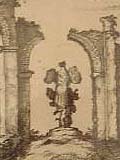Palladio & Schenk
Palladio
Through this volume, Palladio became the most imitated architect of all
time. His Four Books of Architecture were respectively devoted to materials
and building techniques, houses, streets and public buildings, and Roman
temples. This well-known cutaway perspective of the circular Pantheon
is from the fourth book. Palladio argued that the circle was beautiful
because of the movement of the cosmos and that the ‘simple, uniform,
equal, strong and spacious' shape was visible evidence of the ‘Oneness,
the Infinite Essence, the Uniformity, and the Justice of God.' The
Pantheon was the largest domed structure in the world at that time. The
exhibited volume is the second edition of this canonical work and was
published a year after the architect's death.
List of items
Schenk 
IThis publication by Amsterdam publisher and engraver Peter Schenk is
typical of those that were appearing at the turn of the 18th century.
The page shown depicts the ruins of the aqueduct the Aqua Marcia. It conveyed
water to both the baths of Diocletian and to those of Caracalla.
List of items
|
|
|
| Detail. Schenk, Peter. Roma aeterna Petri Schenkii; sive, Ipsius aedificiorum Romanorum integrorum collapsorumque conspectus duplex. s.n., 1705. |
|
